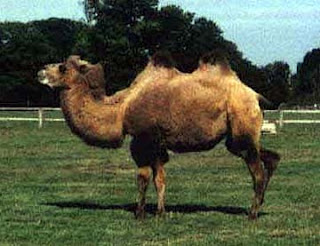Camels have been in the news on this date a couple of times. In 1997 in Berlin. Europe’s first camel races with women jockeys took place. In 2007 a 60 year old woman in Australia died
when her pet camel tried to mate with her. Here are 10 more facts about camels.
- The word camel comes from the Arabic word “gml” which means beauty. A dromedary is a camel which has one hump, and a camel with two is called a Bactrian camel. About 90% of the world’s camels are dromedaries. The Arabic language has over 160 words for camel.
- Many people believe a camel's hump stores Water. It doesn't. It stores fat. A camel can carry up to 36 kilograms (80 pounds) worth of fat on its back at a time. The fat can be converted by the camel into either food or water.
- Camels are adapted to live in areas where water is scarce. They can drink 145 litres or 32 gallons of water in one go, and can survive losing up to 40% of their weight from dehydration. Their urine is like thick syrup, and their faeces are so dry that Beduins can use it for fuel without having to dry it out first. Even their red blood cells are different. They are oval rather than circular which helps them flow when the animal is dehydrated.
- Another hazard camels have to deal with is sandstorms. They have special adaptations to deal with those, too. They have an extra, clear eyelid which protects their eyes from the sand while letting in enough light for them to see. They have two rows of very long eyelashes and can close their nostrils. Hairs in their ears help keep the sand out.
- Then there's the heat. That's one reason for their long legs – they keep the camel's body away from the hot sand. When they need to rest, the camel has a thick pad of skin on its chest and knees so it can sit on the hot sand. Their coats also reflect sunlight to help keep them cool.
- An adult camel is about 1.85 m (6 ft 1 in) tall at the shoulder and 2.15 m (7 ft 1 in) tall at the hump. They can run at up to 65 km/h (40 mph) in short bursts and sustain speeds of up to 40 km/h (25 mph). The average life expectancy of a camel is 40 to 50 years.
- Camels are descended from a prehistoric animal called a Protylopus, which lived in North America 40 to 50 million years ago. This creature was about the size of a Rabbit.
- Like Cows, camels are ruminants and chew cud. They have thick lips which enable them to eat thorny plants other animals can't. Camels are famous for being bad tempered and spitting at people. Spitting is a defence mechanism used when they feel threatened. It's not just saliva, either. As if that's not disgusting enough, they also bring up some of their stomach contents to spit at whatever is threatening them.
- A camel's growl is one of the noises used to create Chewbacca’s voice in the Star Wars films.
- Camels were domesticated more than 3,000 years ago and desert based societies depend on them for many things. Transport is one – a camel can carry 90 kilograms (200 pounds) of extra weight. They can carry goods and also people. Cavalries made up of camels are a thing in Africa, even today (although they are gradually being replaced with vehicles). Horses are said to be afraid of the scent of camels which makes them particularly useful when fighting an army on horseback. A more peaceful use has been found in Kenya, where camels are used as a mobile library to carry books to remote areas. Their hair is used to make clothing, tents and bedding, and they can be eaten – a camel's hump is a delicacy in some desert societies. Their milk is also good for you. It has more Iron and Vitamin C than cow's Milk. Camel milkshake is on sale in Abu Dhabi and in Kazakhstan it's used for medicinal purposes, including as a remedy for tuberculosis.
NEW!!
Over the Rainbow
'We're not in Trinity anymore,' says Leonard Marx, quoting a line from an old Innovian movie. The moon is different; the planes flying overhead are different. Nobody has any idea where they are or if it's possible to get home.
In this strange new world, people from the highly technical Innovia and the less advanced Classica must co-operate in order to survive. In addition, travel through the inter-dimensional wormhole has given some people unusual and unexpected powers.
Innovia mourns the loss of its superhero, Power Blaster, last seen carrying a nuclear bomb to the upper atmosphere away from the inhabited Bird Island. They don't believe he could possibly have survived. Power Blaster has survived, but is close to death and stranded in the new dimension. He is nursed back to health by a Classican woman, Elena. She has no idea who he is, only that she is falling in love with the handsome stranger.
Shanna sets out to discover what happened to Nathan Tate, who didn't return from his hiking holiday, not knowing her life is about to be turned inside out and upside down.
Meanwhile, Desi Troyes, the man responsible for the catastrophe, is at large on the new world, plotting how he can transfer his plans for world domination to the planet he now finds himself on - Earth.


No comments:
Post a Comment